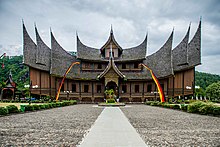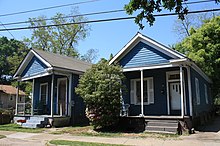
Back عمارة عامية Arabic Arquitectura popular Catalan Lidová architektura Czech Халăх архитектури CV Traditionelle Architektur German Arquitectura popular Spanish معماری بومی Persian Architecture vernaculaire French Arquitectura popular Galician בנייה ורנקולרית HE



Vernacular architecture (also folk architecture[1]) is building done outside any academic tradition, and without professional guidance. It is not a particular architectural movement or style, but rather a broad category, encompassing a wide range and variety of building types, with differing methods of construction, from around the world, both historical and extant and classical and modern.[2][3] Vernacular architecture constitutes 95% of the world's built environment, as estimated in 1995 by Amos Rapoport, as measured against the small percentage of new buildings every year designed by architects and built by engineers.[4]
Vernacular architecture usually serves immediate, local needs, is constrained by the materials available in its particular region and reflects local traditions and cultural practices. The study of vernacular architecture does not examine formally schooled architects, but instead that of the design skills and tradition of local builders, who were rarely given any attribution for the work. More recently, vernacular architecture has been examined by designers and the building industry in an effort to be more energy conscious with contemporary design and construction—part of a broader interest in sustainable design.
As of 1986, even among scholars publishing in the field, the exact boundaries of "vernacular" have not been clear.
- This issue of definition, apparently so simple, has proven to be one of the most serious problems for advocates of vernacular architecture and landscapes research. A straightforward, convincing, authoritative definition has not yet been offered. Vernacular architecture is a phenomenon that many understand intuitively but that few are able to define. The literature on the subject is thus filled with what might be called non-definitions. Vernacular architecture is non-high style building, it is those structures not designed by professionals; it is not monumental; it is un-sophisticated; it is mere building; it is, according to the distinguished historian Nikolaus Pevsner, not architecture. Those who take a more positive approach rely on adjectives like ordinary, everyday, and commonplace. While these terms are not as pejorative as other descriptive phrases that are sometimes applied to the vernacular, neither are they very precise. For example, the skyscrapers of Manhattan are works of high style architecture, but they are also commonplace in Manhattan. Are they not logically New York City vernacular buildings?[5]
Vernacular architecture tends to be overlooked in traditional histories of design. It is not a stylistic description, much less one specific style, so it cannot be summarized in terms of easy-to-understand patterns, characteristics, materials, or elements.[6] Because of the usage of traditional building methods and local builders, vernacular buildings are considered cultural expressions—aboriginal, indigenous, ancestral, rural, ethnic, or regional—as much as architectural artifacts.
- ^ Alcock 2003.
- ^ Caves, R. W. (2004). Encyclopedia of the City. Routledge. p. 750. ISBN 978-0415862875.
- ^ Fewins, Clive. "What is Vernacular Style?". Homebuilding & Renovating. Archived from the original on 23 May 2019. Retrieved 23 May 2019.
- ^ Amos Rapoport, House Form and Culture (Englewood Cliffs, NJ: Prentice-Hall, 1969), 2.
- ^ Upton, Dell; Vlach, John Michael, eds. (1986). Common Places: Readings in American Vernacular Architecture. University of Georgia Press. p. xv. ISBN 9780820307503.
- ^ J. Philip Gruen, “Vernacular Architecture,” in Encyclopedia of Local History, 3d edition, ed. Amy H. Wilson (Lanham, Maryland: Rowman & Littlefield, 2017): 697-98.